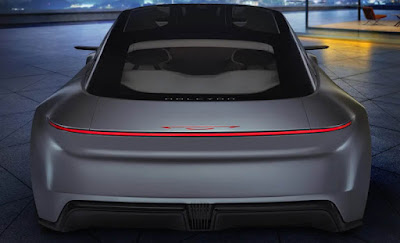New EV - As Chrysler celebrates its upcoming 100th anniversary, the automotive giant is breaking away from its minivan reputation and making a bold leap into the future. Known primarily for producing the Pacifica minivan, Chrysler is unveiling the Halcyon Concept, a sophisticated and stunning roadster with electric power and full autonomous capabilities. This marks a significant departure from their traditional offerings and is a testament to the company's commitment to embracing advanced technology and innovation.
 |
| The Halcyon is a sleek roadster with a lot of interesting things to say about Chrysler’s future. (Picture from: TheVerge) |
Christine Feuell, CEO of the Chrysler brand, emphasizes the brand's progressive vision in introducing advanced technology and experiences tailored for real-life applications. The Halcyon Concept serves as a showcase of Chrysler's future direction, especially considering the company's ambitious plan to exclusively sell electric vehicles by the end of 2028.
 |
| The Halcyon serves as a demonstration of Chrysler's commitment to incorporating cutting-edge technology. (Picture from: TheVerge) |
While the Halcyon is not a production-ready vehicle, lacking specific specifications like battery capacity and mileage, it serves as a demonstration of Chrysler's commitment to incorporating cutting-edge technology. The concept integrates various technologies developed by Chrysler's parent company, Stellantis, including the STLA Brain operating system, STLA AutoDrive driver assistance, and STLA SmartCockpit infotainment system.
 |
| The Halcyon boasts a sleek design with a mere four inches of ground clearance and innovative French door-style openings. (Picture from: TheVerge) |
Built on Stellantis' STLA Large platform, the Halcyon Concept boasts a sleek design with a mere four inches of ground clearance and innovative French door-style openings. The use of recycled materials, such as crushed and recycled music CDs for the company's wing logo, highlights Chrysler's dedication to sustainability, with 95 percent of the interior crafted from "sustainable" materials.
 |
| The Halcyon integrates various technologies developed by Chrysler's parent company, Stellantis, including the STLA Brain operating system, STLA AutoDrive driver assistance, and STLA SmartCockpit infotainment system. (Picture from: TheVerge) |
Artificial intelligence plays a pivotal role in the Halcyon Concept, contributing to features like voice assistants, predictive navigation, and online software updates. The vehicle's ability to recognize user preferences and make preemptive adjustments to the HVAC system enhances the overall driving experience.
 |
| The Halcyon Concept contributes to features such as voice assistants, predictive navigation, and online software updates. (Picture from: TheVerge) |
Chrysler envisions a future where autonomous vehicles play a significant role, and the Halcyon Concept aligns with this vision. Equipped with autonomous features and futuristic elements like a brightness-adjustable glass canopy and Dynamic Wireless Power Transfer Technology, the concept hints at a potential future where wireless charging on the move becomes a reality.
 |
| The use of recycled materials, such as crushed and recycled music CDs for the company's wing logo, highlights Chrysler's dedication to sustainability, with 95 percent of the interior crafted from "sustainable" materials. (Picture from: TheVerge) |
 |
| The Halcyon equipped with autonomous features and futuristic elements like a brightness-adjustable glass canopy and Dynamic Wireless Power Transfer Technology. (Picture from: TheVerge) |
Looking beyond the concept, Chrysler plans to reveal its first electric vehicle in 2025, with the Airflow SUV prototype already showcased. Despite discontinuing the Chrysler 300 sedan, the company remains focused on profitability and increasing its brand value. With approximately 133,000 minivans sold last year, Chrysler aims to leverage its revenue for developing a series of electric vehicles and maintaining a prominent position in the evolving automotive landscape.
 In conclusion, Chrysler's Halcyon Concept serves as a beacon of the company's future direction, emphasizing innovation, sustainability, and a commitment to staying at the forefront of automotive technology. As the automotive industry continues to evolve, Chrysler positions itself as a key player, ready to embrace the challenges and opportunities that lie ahead. *** [EKA | FROM VARIOUS SOURCES | CHRYSLER | THEVERGE | CARANDDRIVER | CNBC | ELECTREK.CO ]
In conclusion, Chrysler's Halcyon Concept serves as a beacon of the company's future direction, emphasizing innovation, sustainability, and a commitment to staying at the forefront of automotive technology. As the automotive industry continues to evolve, Chrysler positions itself as a key player, ready to embrace the challenges and opportunities that lie ahead. *** [EKA | FROM VARIOUS SOURCES | CHRYSLER | THEVERGE | CARANDDRIVER | CNBC | ELECTREK.CO ]Note: This blog can be accessed via your smart phone.
































